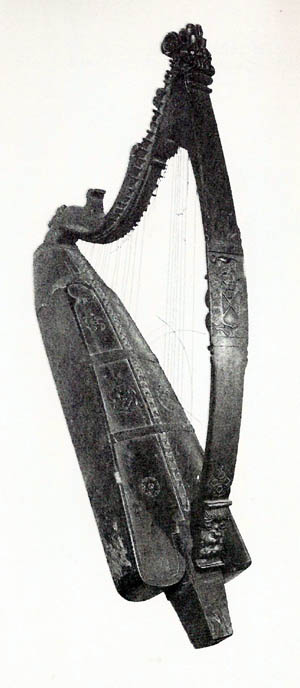
Photograph from The Irish and Highland Harps
by Robert Bruce Armstrong
| Feature | Detail |
|---|---|
| Date | 17th century |
| String Count | Probably 39 originally, now 38 |
| Height | 143 cm (56 inches) |
| Soundbox | Hollowed out from a single block (“willow”), maximum width 35 cm (14 inches) |
| Current Location | The National Museum of Ireland, Collins Barracks, Dublin. |
This harp is thought to have been made in 1672 for Robert, the second son of George, sixteenth Earl of Kildare.
For Robert Bruce Armstrong’s account of this harp, see The Irish and Highland Harps pages 70 through 72. Be sure to view the plate on the un–numbered page facing page 72. Armstrong included three plates for this harp in his description, as well as drawings, measurements and observations on this harp.
Please click on the above images to see a larger version of the pictures. You may then hover over the enlarged images to scroll through them.
The dating of this harp is surrounded with a degree of ambiguity. O’Curry in one of his lectures claiming to be quoting a letter from George Petrie states that it had the date 1672 inscribed in Arabic numerals above an escutcheon with the Kildare Fitzgerald arms on the fore–pillar of the harp. Whether this was exactly what Petrie had said or if O’Curry himself had ever seen the harp is not presently known, but the date which does occupy that space, although one digit is open to interpretation, would be hard to misread as 1672; especially as Petrie had once had the harp in his possession for some ten years or more.
Click here to read further on the Dates of the Kildare Harp
When writing his section on the Kildare Harp, Armstrong gives the following information on page 72:
This really splendid Harp was obtained by the late Dr. George Petrie from a poor woman who had purchased it an auction in Dublin. Dr. Petrie upon discovering for whom it had been made thought that it should belong to the head of the family, and presented it to the fourth Duke of Leinster in 1849, since which time it has been preserved at Kilkea Castle and has been known as the Kildare Harp.
Click here to read further on George Petrie and the Kildare Harp